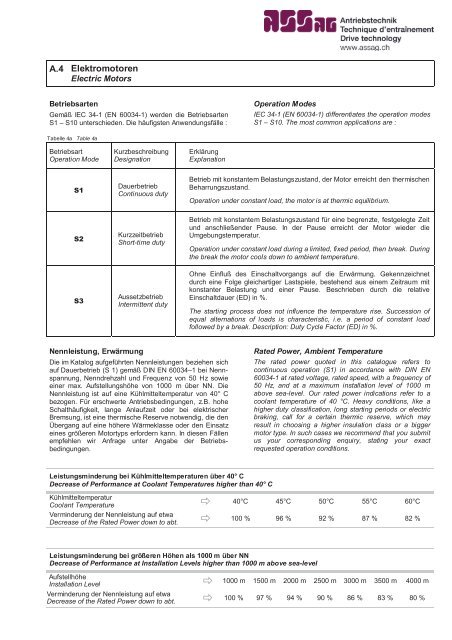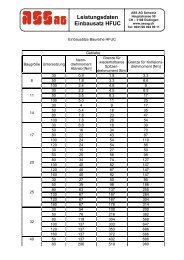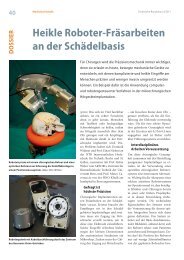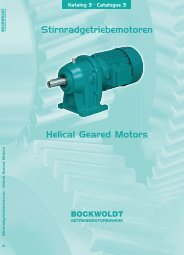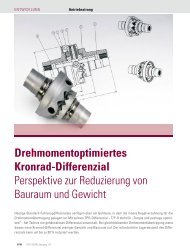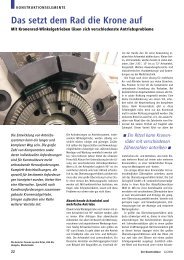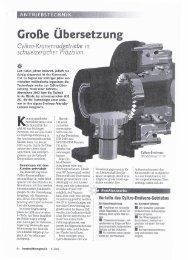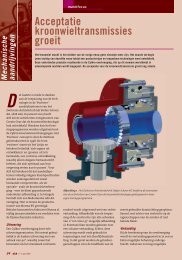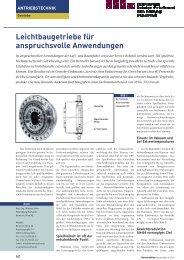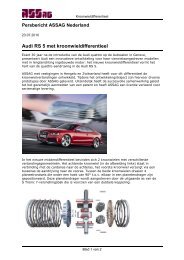Dokumentation Flachgetriebe (pdf.-File) - ASSAG :: Antriebstechnik
Dokumentation Flachgetriebe (pdf.-File) - ASSAG :: Antriebstechnik
Dokumentation Flachgetriebe (pdf.-File) - ASSAG :: Antriebstechnik
You also want an ePaper? Increase the reach of your titles
YUMPU automatically turns print PDFs into web optimized ePapers that Google loves.
A.4 Elektromotoren<br />
Electric Motors<br />
Betriebsarten<br />
Gemäß IEC 34-1 (EN 60034-1) werden die Betriebsarten<br />
S1 – S10 unterschieden. Die häufigsten Anwendungsfälle :<br />
Tabelle 4a Table 4a<br />
Betriebsart<br />
Operation Mode<br />
S1<br />
S2<br />
S3<br />
Kurzbeschreibung<br />
Designation<br />
Dauerbetrieb<br />
Continuous duty<br />
Kurzzeitbetrieb<br />
Short-time duty<br />
Aussetzbetrieb<br />
Intermittent duty<br />
Nennleistung, Erwärmung<br />
Erklärung<br />
Explanation<br />
Die im Katalog aufgeführten Nennleistungen beziehen sich<br />
auf Dauerbetrieb (S 1) gemäß DIN EN 60034–1 bei Nennspannung,<br />
Nenndrehzahl und Frequenz von 50 Hz sowie<br />
einer max. Aufstellungshöhe von 1000 m über NN. Die<br />
Nennleistung ist auf eine Kühlmitteltemperatur von 40° C<br />
bezogen. Für erschwerte Antriebsbedingungen, z.B. hohe<br />
Schalthäufigkeit, lange Anlaufzeit oder bei elektrischer<br />
Bremsung, ist eine thermische Reserve notwendig, die den<br />
Übergang auf eine höhere Wärmeklasse oder den Einsatz<br />
eines größeren Motortyps erfordern kann. In diesen Fällen<br />
empfehlen wir Anfrage unter Angabe der Betriebsbedingungen.<br />
Leistungsminderung bei Kühlmitteltemperaturen über 40° C<br />
Decrease of Performance at Coolant Temperatures higher than 40° C<br />
Operation Modes<br />
IEC 34-1 (EN 60034-1) differentiates the operation modes<br />
S1 – S10. The most common applications are :<br />
Betrieb mit konstantem Belastungszustand, der Motor erreicht den thermischen<br />
Beharrungszustand.<br />
Operation under constant load, the motor is at thermic equilibrium.<br />
Betrieb mit konstantem Belastungszustand für eine begrenzte, festgelegte Zeit<br />
und anschließender Pause. In der Pause erreicht der Motor wieder die<br />
Umgebungstemperatur.<br />
Operation under constant load during a limited, fixed period, then break. During<br />
the break the motor cools down to ambient temperature.<br />
Ohne Einfluß des Einschaltvorgangs auf die Erwärmung. Gekennzeichnet<br />
durch eine Folge gleichartiger Lastspiele, bestehend aus einem Zeitraum mit<br />
konstanter Belastung und einer Pause. Beschrieben durch die relative<br />
Einschaltdauer (ED) in %.<br />
The starting process does not influence the temperature rise. Succession of<br />
equal alternations of loads is characteristic, i.e. a period of constant load<br />
followed by a break. Description: Duty Cycle Factor (ED) in %.<br />
Rated Power, Ambient Temperature<br />
The rated power quoted in this catalogue refers to<br />
continuous operation (S1) in accordance with DIN EN<br />
60034-1 at rated voltage, rated speed, with a frequency of<br />
50 Hz, and at a maximum installation level of 1000 m<br />
above sea-level. Our rated power indications refer to a<br />
coolant temperature of 40 °C. Heavy conditions, like a<br />
higher duty classification, long starting periods or electric<br />
braking, call for a certain thermic reserve, which may<br />
result in choosing a higher insulation class or a bigger<br />
motor type. In such cases we recommend that you submit<br />
us your corresponding enquiry, stating your exact<br />
requested operation conditions.<br />
Kühlmitteltemperatur<br />
Coolant Temperature � 40°C 45°C 50°C 55°C 60°C<br />
Verminderung der Nennleistung auf etwa<br />
Decrease of the Rated Power down to abt. � 100 % 96 % 92 % 87 % 82 %<br />
Leistungsminderung bei größeren Höhen als 1000 m über NN<br />
Decrease of Performance at Installation Levels higher than 1000 m above sea-level<br />
Aufstellhöhe<br />
Installation Level �<br />
Verminderung der Nennleistung auf etwa<br />
Decrease of the Rated Power down to abt. �<br />
1000 m 1500 m 2000 m 2500 m 3000 m 3500 m 4000 m<br />
100 % 97 % 94 % 90 % 86 % 83 % 80 %


